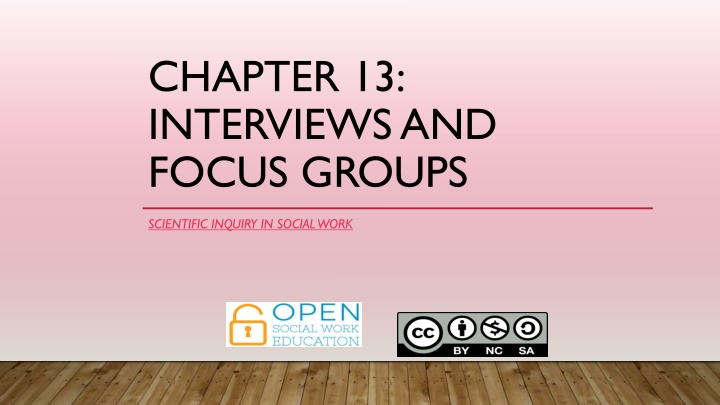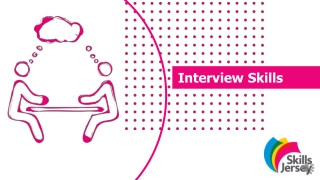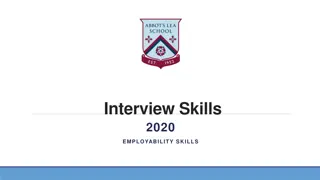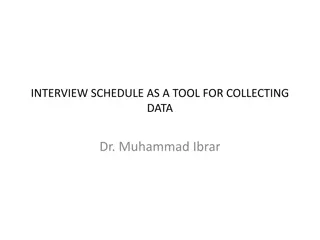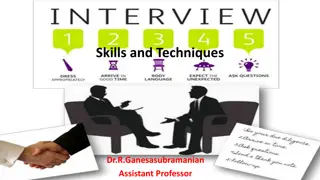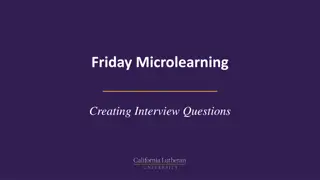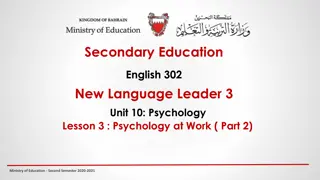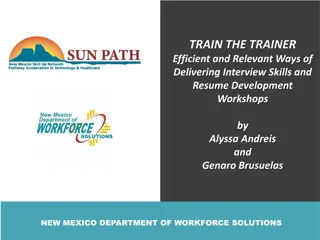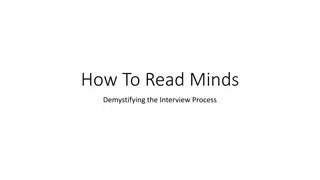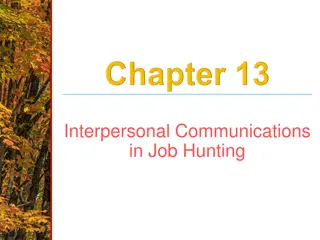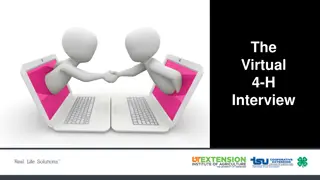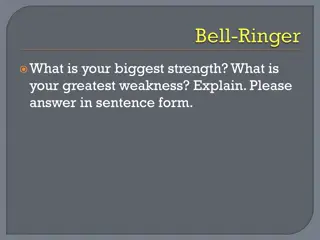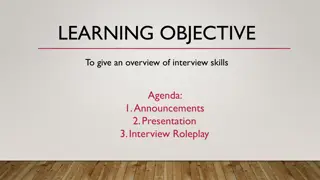Interview Research Essentials: Techniques, Benefits & Considerations
This comprehensive chapter delves into interview research, covering qualitative techniques, focus groups, and analyzing data. Discover the benefits, features, and considerations of interviews, including in-depth, semi-structured interviews. Explore interview techniques through a study on state administrators of HCBS services, discussing decision-making processes, outcomes assessment, organizational strengths, challenges, and resource utilization.
Download Presentation

Please find below an Image/Link to download the presentation.
The content on the website is provided AS IS for your information and personal use only. It may not be sold, licensed, or shared on other websites without obtaining consent from the author.If you encounter any issues during the download, it is possible that the publisher has removed the file from their server.
You are allowed to download the files provided on this website for personal or commercial use, subject to the condition that they are used lawfully. All files are the property of their respective owners.
The content on the website is provided AS IS for your information and personal use only. It may not be sold, licensed, or shared on other websites without obtaining consent from the author.
E N D
Presentation Transcript
CHAPTER 13: INTERVIEWS AND FOCUS GROUPS SCIENTIFIC INQUIRY IN SOCIAL WORK
CHAPTER OVERVIEW This chapter covers the basics of interview research: What is it and when should it be used? Qualitative interview techniques Issues to consider for all interview types Focus groups Analyzing qualitative data
BENEFITS AND FEATURES OF INTERVIEWS Useful for exchanging complex information As opposed to operational definitions You can ask follow-up questions People s stories are captured - interesting Lengthy explanations Participants can reflect out loud about their responses Studying processes and exploring unknown topics
In-depth interviews Semi-structured and flexible Interview guide Open-ended questions INTERVIEW TECHNIQUES AND CONSIDERATIONS A question from Dr. DeCarlo s study on state administrators of HCBS services In your pre-interview, you provided a list of goods and services covered in self-directed supports. How did you make the determination to include those services? Did you make the decision to exclude other goods and services? Have there been any issues in your state around what goods and services are covered in self- direction? Have you received any feedback from self-directed waiver participants about goods and services?
INTERVIEW TECHNIQUES AND CONSIDERATIONS (CONTINUED) What is working well with self-directed supports in your state? What outcomes are important for you in assessing the effectiveness of self-directed supports? What strengths in your organization have been helpful in implementing self-direction? What (internal and external) resources were helpful in implementing self-direction? What are the primary challenges with self-directed supports in your state? How has your organization overcome these challenges? What (internal and external) resources were helpful in overcoming these challenges? Are there any social, economic, or political trends unique to your state that have affected implementation? In your opinion, what changes could be made to your state s self-directed service options to make them better? What resources might be needed to make these changes? What outcomes are important to you?
CREATING AN INTERVIEW GUIDE Brainstorming Grouping similar questions together Working up to sensitive questions Seeking feedback from other researchers Research teams, peer reviewers, auditors Methodological journal
CREATING AN INTERVIEW GUIDE (CONTINUED) Avoid yes/no questions or closed questions that have a one word answer Use probes: Can you tell me a little more about that? Avoid leading questions, remain objective Write open-ended questions
INTERVIEW TECHNIQUES Audio-recording: pros and cons Neutral setting vs. natural setting Field notes Transcription of recordings Noting non-verbal cues
ANALYZING INTERVIEW DATA Code: shorthand for a complex idea (meaning unit) Coding: identifying ideas in the text Open coding: note categories or themes with an open mind Focused coding: collapsing themes, building connections, and setting descriptions Coding matrix Asking: Of what topic, unit, or aspect is this an instance? What question about a topic does this item of data suggest? What sort of answer to a question about a topic does this item of data suggest (i.e., what proposition is suggested)?
QUALITATIVE METHODS Time-consuming Rely on self-report Emotionally draining (depending on topic) Example: exploratory study to determine why women drop protective orders against violent partners
ISSUES IN INTERVIEWING Power Location Relationships Researcher edits the truth when telling the public Use of self- disclosure Clear intent Finding a location that is convenient and comfortable for participant May evoke sensitivity Respect and rapport Gratitude Active listening
FOCUS GROUPS Multiple participants Focus on group interactions Non-verbal and verbal Facilitator/moderator Confidentiality concerns Group size Familiar vs. unfamiliar participants Multiple viewpoints
STRENGTHS AND WEAKNESSES OF FOCUS GROUPS Strengths Weaknesses Yield detailed, in-depth data Expensive Less time-consuming than one-on-one interviews May be more time-consuming than survey research Useful for studying social processes Minority of participants may dominate entire group Allow researchers to observe body language in addition to self-reports Allow researchers to observe interaction between multiple participants
